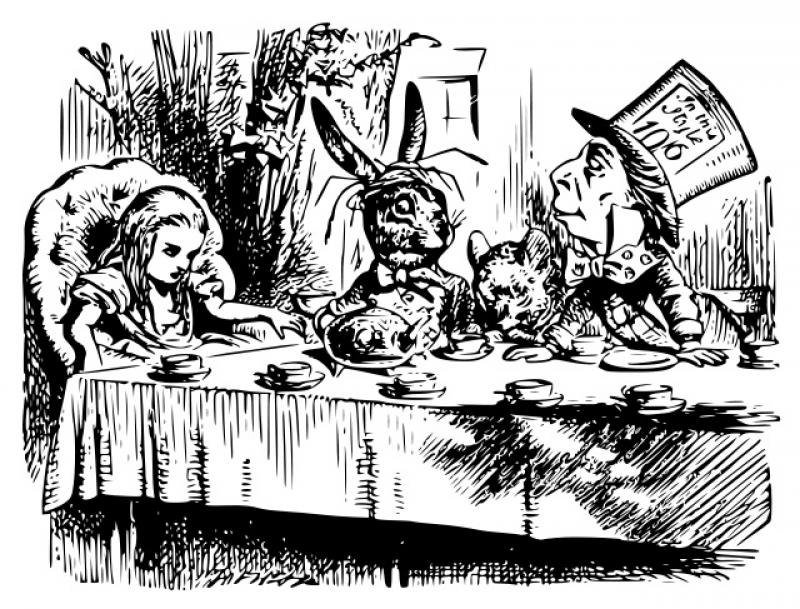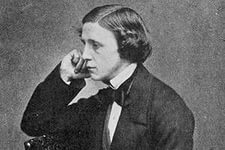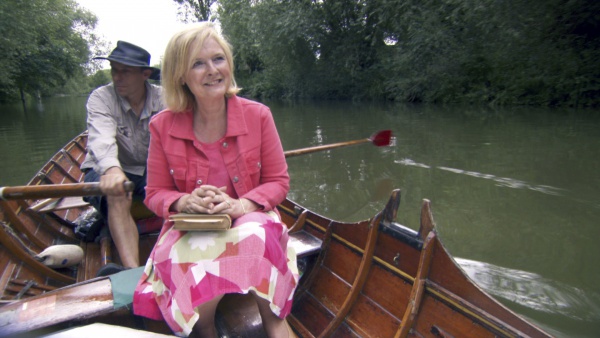The Secret World of Lewis Carroll, BBC Two | reviews, news & interviews
The Secret World of Lewis Carroll, BBC Two
The Secret World of Lewis Carroll, BBC Two
150 years on, Carroll’s surreal, truthful masterpiece under the magnifying glass

Alice is always with us; the most quoted work of literature, after the Bible and Shakespeare. In fact, Desert Island Discs should probably add Alice to the mandatory Bible and Shakespeare as an automatic inclusion for the survival kit.
In the past few years alone there has been a major exhibition at Tate Liverpool of artists affected by Alice from Salvador Dali to Sigmar Polke, and a three-act ballet for the Royal Opera House by Christopher Wheeldon; another exhibition of books, documents and photographs will open in May at the Museum of Childhood. Not to mention endless biographies of the author, and a published selection of his letters (he wrote, it is estimated, some 98,000 in his lifetime), numerous illustrated editions by different artists, and scholarly studies of all the jokes and allusions readily apparent to the intelligentsia of the time, but obscure in the 21st century.
Rabbits hopped down rabbit holes, Alice illustrations sprung animatedly to life
And now that astute television and radio journalist Martha Kearney, who when a ten-year-old herself played Alice to critical acclaim for the Ditchling Players in Sussex, presents a narrative about the author. Lewis Carroll was the son of a vicar, one of ten children (as a child he devised many an entertainment for his siblings), had a speech impediment, was officially celibate all his life, and evidently and surprisingly (although not explored here) was a dull tutor, although a witty deviser of puzzles, a good amateur artist and a superb photographer.
Kearney gracefully wove together interviews with novelists (Philip Pullman, suggesting his Lara is a direct descendant of Alice; Will Self reminding us you do not have to be a good man to write a great book); and biographers, scholars and relatives, including the great-granddaughter of the child who inspired Alice, and the great-great niece of the author himself. We visited the sites of Oxford and the Thames that framed Carroll’s life and were painlessly introduced to Victorian society of the time, and specifically Carroll’s involvement with the Liddell family at Christ Church.
The Liddell father was the Dean of Christ Church, a position of enormous prestige, and his wife such a snob that she was called the Kingfisher, as she angled for acquaintances with various royals. Their family of six contained three daughters, including Alice, who were warmly befriended by Carroll, and we were shown the very view of the beautiful walled garden of Christ Church belonging to the Deanery, that Carroll had from the college’s library, and from which vantage point he first saw the daughters at play.
 Alice’s Adventures in Wonderland was a tale told to Alice Liddell, notably on a long summer day on the Thames, rowing from Oxford to Godstowe (Kearney, below left, on the river); it was Alice who wanted it written down, and to whom Carroll gave his original manuscript. Now the city of Oxford has an Alice Day on the 4th of July every year to mark the summer on which the tales of Alice were first told.
Alice’s Adventures in Wonderland was a tale told to Alice Liddell, notably on a long summer day on the Thames, rowing from Oxford to Godstowe (Kearney, below left, on the river); it was Alice who wanted it written down, and to whom Carroll gave his original manuscript. Now the city of Oxford has an Alice Day on the 4th of July every year to mark the summer on which the tales of Alice were first told.
The real-life story and the fictional world were interwoven in the programme. Rabbits hopped down rabbit holes, Alice illustrations sprung animatedly to life, and there were scenes of serene beauty offered by Christ Church itself. (The college’s dining hall was used indeed for Hogwarts in the Harry Potter films, and someone could not resist saying Alice was, so to speak, the Harry Potter of her day.)
Carroll was a pioneering and passionate photographer, perhaps in more ways than one. He took portrait photographs of the grandees of the day, but it is the scores of images of children which seem so suspicious to us today; we were shown an interesting parallel with that other great amateur, Julia Margaret Cameron, who also photographed the same subjects.
The programme concluded with an examination of his photographs, sometimes turned into coloured illustrations, of naked young girls. We were told this interest was not thought suspect at the time, as sexually immature children were thought to be innocent, while an interest in adolescent children would have set off warning bells. The age of consent, by the way, in the 1860s was 12.
 The discovery – perhaps Carroll’s “secret” world – was of a photograph possibly but not proven to be by Carroll of (again, possibly) Lorina, Alice’s older sister, in the collection of the Museum Cantini in Marseilles. The model is naked and definitely already pubescent.
The discovery – perhaps Carroll’s “secret” world – was of a photograph possibly but not proven to be by Carroll of (again, possibly) Lorina, Alice’s older sister, in the collection of the Museum Cantini in Marseilles. The model is naked and definitely already pubescent.
Various suggestions were made as to what we should make of Carroll’s fascination with pre-pubescent girls, and the significance of this newly discovered photograph. The evidence is in fact scant. But there was indeed an unexplained rift with the Liddell family, never to be completely healed, as the daughters reached adolescence. Carroll’s family excised from and destroyed the pages of his extensive diaries anything that might have explained what happened.
But we were reminded that it was a period when children became central figures in Victorian literature, with authors as various as Charles Dickens to Charles Kingsley. Carroll’s Alice was calm, feisty, composed, and full of common sense in a mad world. At its best this gorgeous journey into the English heartland showed us again the wonders of Carroll’s surreal and truthful masterpiece.
rating
Share this article
The future of Arts Journalism
You can stop theartsdesk.com closing!
We urgently need financing to survive. Our fundraising drive has thus far raised £49,000 but we need to reach £100,000 or we will be forced to close. Please contribute here: https://gofund.me/c3f6033d
And if you can forward this information to anyone who might assist, we’d be grateful.

Subscribe to theartsdesk.com
Thank you for continuing to read our work on theartsdesk.com. For unlimited access to every article in its entirety, including our archive of more than 15,000 pieces, we're asking for £5 per month or £40 per year. We feel it's a very good deal, and hope you do too.
To take a subscription now simply click here.
And if you're looking for that extra gift for a friend or family member, why not treat them to a theartsdesk.com gift subscription?
more TV
 Down Cemetery Road, Apple TV review - wit, grit and a twisty plot, plus Emma Thompson on top form
Mick Herron's female private investigator gets a stellar adaptation
Down Cemetery Road, Apple TV review - wit, grit and a twisty plot, plus Emma Thompson on top form
Mick Herron's female private investigator gets a stellar adaptation
 theartsdesk Q&A: director Stefano Sollima on the relevance of true crime story 'The Monster of Florence'
The director of hit TV series 'Gomorrah' examines another dark dimension of Italian culture
theartsdesk Q&A: director Stefano Sollima on the relevance of true crime story 'The Monster of Florence'
The director of hit TV series 'Gomorrah' examines another dark dimension of Italian culture
 The Monster of Florence, Netflix review - dramatisation of notorious Italian serial killer mystery
Director Stefano Sollima's four-parter makes gruelling viewing
The Monster of Florence, Netflix review - dramatisation of notorious Italian serial killer mystery
Director Stefano Sollima's four-parter makes gruelling viewing
 The Diplomat, Season 3, Netflix review - Ambassador Kate Wyler becomes America's Second Lady
Soapy transatlantic political drama keeps the Special Relationship alive
The Diplomat, Season 3, Netflix review - Ambassador Kate Wyler becomes America's Second Lady
Soapy transatlantic political drama keeps the Special Relationship alive
 The Perfect Neighbor, Netflix review - Florida found-footage documentary is a harrowing watch
Sundance winner chronicles a death that should have been prevented
The Perfect Neighbor, Netflix review - Florida found-footage documentary is a harrowing watch
Sundance winner chronicles a death that should have been prevented
 Murder Before Evensong, Acorn TV review - death comes to the picturesque village of Champton
The Rev Richard Coles's sleuthing cleric hits the screen
Murder Before Evensong, Acorn TV review - death comes to the picturesque village of Champton
The Rev Richard Coles's sleuthing cleric hits the screen
 Black Rabbit, Netflix review - grime and punishment in New York City
Jude Law and Jason Bateman tread the thin line between love and hate
Black Rabbit, Netflix review - grime and punishment in New York City
Jude Law and Jason Bateman tread the thin line between love and hate
 The Hack, ITV review - plodding anatomy of twin UK scandals
Jack Thorne's skill can't disguise the bagginess of his double-headed material
The Hack, ITV review - plodding anatomy of twin UK scandals
Jack Thorne's skill can't disguise the bagginess of his double-headed material
 Slow Horses, Series 5, Apple TV+ review - terror, trauma and impeccable comic timing
Jackson Lamb's band of MI5 misfits continues to fascinate and amuse
Slow Horses, Series 5, Apple TV+ review - terror, trauma and impeccable comic timing
Jackson Lamb's band of MI5 misfits continues to fascinate and amuse
 Coldwater, ITV1 review - horror and black comedy in the Highlands
Superb cast lights up David Ireland's cunning thriller
Coldwater, ITV1 review - horror and black comedy in the Highlands
Superb cast lights up David Ireland's cunning thriller
 Blu-ray: The Sweeney - Series One
Influential and entertaining 1970s police drama, handsomely restored
Blu-ray: The Sweeney - Series One
Influential and entertaining 1970s police drama, handsomely restored
 I Fought the Law, ITVX review - how an 800-year-old law was challenged and changed
Sheridan Smith's raw performance dominates ITV's new docudrama about injustice
I Fought the Law, ITVX review - how an 800-year-old law was challenged and changed
Sheridan Smith's raw performance dominates ITV's new docudrama about injustice

Add comment